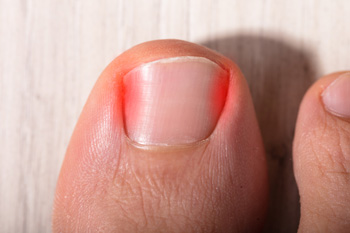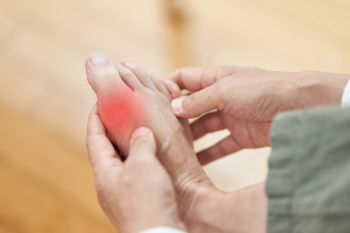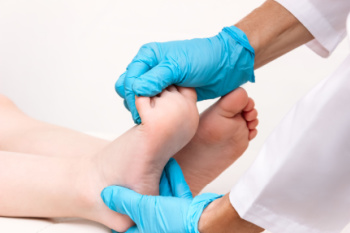Items filtered by date: June 2025
New and Traditional Ways to Treat Ingrown Toenails

Ingrown toenails can be painful and persistent, but treatment options continue to evolve. Conservative care remains a first step for many. This includes warm salt soaks, gentle lifting of the nail edge, or protective padding to reduce pressure. Proper trimming techniques and footwear changes can also help prevent recurrence. When conservative measures do not bring relief, more advanced options may be considered. Newer treatments include partial nail removal combined with techniques to prevent regrowth along the problematic edge. This offers a long-term solution with minimal discomfort. In some cases, laser or chemical procedures are used to address the nail root directly. With both time-tested and modern approaches available, treatment can be tailored to fit each person’s needs and lifestyle. If you have recurring or painful ingrown toenails, it is suggested that you schedule an appointment with a podiatrist for a diagnosis and treatment deemed best for you.
Ingrown toenails may initially present themselves as a minor discomfort, but they may progress into an infection in the skin without proper treatment. For more information about ingrown toenails, contact Gabrielle Clark, DPM of LA Feet Foot & Ankle Center, Inc. Our doctor can provide the care you need to keep you pain-free and on your feet.
Ingrown Toenails
Ingrown toenails are caused when the corner or side of a toenail grows into the soft flesh surrounding it. They often result in redness, swelling, pain, and in some cases, infection. This condition typically affects the big toe and may recur if it is not treated properly.
Causes
- Improper toenail trimming
- Genetics
- Improper shoe fitting
- Injury from pedicures or nail picking
- Abnormal gait
- Poor hygiene
You are more likely to develop an ingrown toenail if you are obese, have diabetes, arthritis, or have any fungal infection in your nails. Additionally, people who have foot or toe deformities are at a higher risk of developing an ingrown toenail.
Symptoms
Some symptoms of ingrown toenails are redness, swelling, and pain. In rare cases, there may be a yellowish drainage coming from the nail.
Treatment
Ignoring an ingrown toenail can have serious complications. Infections of the nail border can progress to a deeper soft-tissue infection, which can then turn into a bone infection. You should always speak with your podiatrist if you suspect you have an ingrown toenail, especially if you have diabetes or poor circulation.
If you have any questions, please feel free to contact our offices located in New Orleans, and Metairie, LA . We offer the newest diagnostic and treatment technologies for all your foot care needs.
Understanding Painful Gout

Gout is a form of arthritis that causes sudden, severe pain in the joints, most commonly in the big toe. It occurs when uric acid builds up in the blood, forming sharp crystals in the joints. This condition is often triggered by factors like a diet high in purines, which are found in red meat, seafood, and alcohol. Other risk factors include dehydration, obesity, or a family history of gout. Symptoms of gout include intense pain, swelling, redness, and warmth in the affected joint, often making even the light touch of a blanket unbearable. Attacks typically occur at night and can last for several days. A podiatrist can diagnose gout by evaluating your symptoms, performing a physical examination, and ordering blood tests or joint fluid analysis to check uric acid levels. Treatment options include medication to reduce inflammation, pain management, dietary recommendations, and lifestyle changes to prevent future flare-ups. If you have painful gout, it is suggested that you are under the care of a podiatrist.
Gout is a painful condition that can be treated. If you are seeking treatment, contact Gabrielle Clark, DPM from LA Feet Foot & Ankle Center, Inc. Our doctor will treat your foot and ankle needs.
What Is Gout?
Gout is a form of arthritis that is characterized by sudden, severe attacks of pain, redness, and tenderness in the joints. The condition usually affects the joint at the base of the big toe. A gout attack can occur at any random time, such as the middle of the night while you are asleep.
Symptoms
- Intense Joint Pain - Usually around the large joint of your big toe, and it most severe within the first four to twelve hours
- Lingering Discomfort - Joint discomfort may last from a few days to a few weeks
- Inflammation and Redness -Affected joints may become swollen, tender, warm and red
- Limited Range of Motion - May experience a decrease in joint mobility
Risk Factors
- Genetics - If family members have gout, you’re more likely to have it
- Medications - Diuretic medications can raise uric acid levels
- Gender/Age - Gout is more common in men until the age of 60. It is believed that estrogen protects women until that point
- Diet - Eating red meat and shellfish increases your risk
- Alcohol - Having more than two alcoholic drinks per day increases your risk
- Obesity - Obese people are at a higher risk for gout
Prior to visiting your podiatrist to receive treatment for gout, there are a few things you should do beforehand. If you have gout you should write down your symptoms--including when they started and how often you experience them, important medical information you may have, and any questions you may have. Writing down these three things will help your podiatrist in assessing your specific situation so that he or she may provide the best route of treatment for you.
If you have any questions, please feel free to contact our offices located in New Orleans, and Metairie, LA . We offer the newest diagnostic and treatment technologies for all your foot care needs.
Toenail Fungus in Children

Onychomycosis, or toenail fungus, can affect children, although it is more common in adults. This condition develops when fungi invade the nail bed, often after exposure in warm, damp environments such as locker rooms or around swimming pools. The infected nail may become thickened, discolored, brittle, or distorted in shape. While it is usually not painful at first, the appearance of the nail can cause concern and discomfort over time. Children with sweaty feet, tight shoes, or minor nail trauma may be more at risk. Because fungal infections are unlikely to clear up without help, early attention is important. Treatment may involve topical medications or, in some cases, oral antifungal medicine. If your child has toenails that appear yellow, rough, or unusually shaped, it is suggested that you visit a podiatrist to confirm the diagnosis and discuss the most appropriate treatment options.
For more information about treatment, contact Gabrielle Clark, DPM of LA Feet Foot & Ankle Center, Inc. Our doctor can provide the care you need to keep you pain-free and on your feet.
Toenail Fungus Treatment
Toenail fungus is a condition that affects many people and can be especially hard to get rid of. Fortunately, there are several methods to go about treating and avoiding it.
Antifungals & Deterrence
Oral antifungal medicine has been shown to be effective in many cases. It is important to consult with a podiatrist to determine the proper regiment for you, or potentially explore other options.
Applying foot powder on the feet and shoes helps keep the feet free of moisture and sweat.
Sandals or open toed shoes – Wearing these will allow air movement and help keep feet dry. They also expose your feet to light, which fungus cannot tolerate. Socks with moisture wicking material also help as well.
If you have any questions please feel free to contact our offices located in New Orleans, and Metairie, LA . We offer the newest diagnostic tools and technology to treat your foot and ankle needs.
Achilles Tendon Rupture Can Lead to an Ankle Fracture

A sudden rupture of the achilles tendon is a serious injury that can sometimes be linked to an ankle fracture. The achilles tendon connects the calf muscles to the heel bone and helps with walking, running, and jumping. When it tears, the force involved can be strong enough to stress the surrounding bones and joints. In certain cases, this trauma may cause small fractures near the ankle, especially if the foot is planted or twisted during the injury. Pain, swelling, bruising, and difficulty in walking are common signs of both injuries. Because the symptoms can overlap, imaging is often needed to confirm a fracture. Healing from both a rupture and a fracture may involve immobilization, targeted exercises, or surgery. If you experience a sudden pop in your heel followed by severe pain or swelling, it is suggested that you see a podiatrist for a proper diagnosis and appropriate treatment.
Achilles tendon injuries need immediate attention to avoid future complications. If you have any concerns, contact Gabrielle Clark, DPM of LA Feet Foot & Ankle Center, Inc. Our doctor can provide the care you need to keep you pain-free and on your feet.
What Is the Achilles Tendon?
The Achilles tendon is a tendon that connects the lower leg muscles and calf to the heel of the foot. It is the strongest tendon in the human body and is essential for making movement possible. Because this tendon is such an integral part of the body, any injuries to it can create immense difficulties and should immediately be presented to a doctor.
What Are the Symptoms of an Achilles Tendon Injury?
There are various types of injuries that can affect the Achilles tendon. The two most common injuries are Achilles tendinitis and ruptures of the tendon.
Achilles Tendinitis Symptoms
- Inflammation
- Dull to severe pain
- Increased blood flow to the tendon
- Thickening of the tendon
Rupture Symptoms
- Extreme pain and swelling in the foot
- Total immobility
Treatment and Prevention
Achilles tendon injuries are diagnosed by a thorough physical evaluation, which can include an MRI. Treatment involves rest, physical therapy, and in some cases, surgery. However, various preventative measures can be taken to avoid these injuries, such as:
- Thorough stretching of the tendon before and after exercise
- Strengthening exercises like calf raises, squats, leg curls, leg extensions, leg raises, lunges, and leg presses
If you have any questions please feel free to contact our offices located in New Orleans, and Metairie, LA . We offer the newest diagnostic tools and technology to treat your foot and ankle needs.
